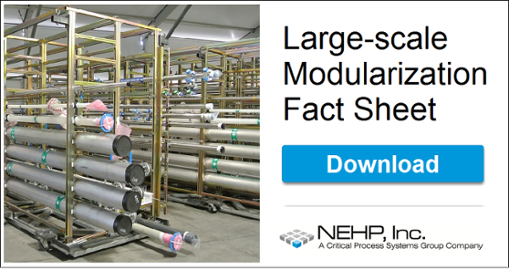/Large-scale%20modularization%20module.png?width=421&name=Large-scale%20modularization%20module.png)
WHAT IS LEAN CONSTRUCTION INTEGRATION?
HOW DOES Lean Construction Integration WORK?
/8%20Wastes%20of%20Lean%20Downtime%20Infographic.png?width=491&name=8%20Wastes%20of%20Lean%20Downtime%20Infographic.png)
Lean construction integration drives change at every level to improve the reliability of work assignments and, therefore, work flow. It borrows key tools and concepts from the Lean method of manufacturing - such as the Last Planner System, Value Stream Mapping, Root Cause Analysis, Continuous Improvement, Just In Time Construction (JIT) Delivery, and Lean Construction Waste Identification to name a few - and applies these to relevant processes within the construction industry.
Another major component of its success is the transfer of certain construction activities into a manufacturing environment. This not only makes it easier to apply Lean principles, but it affords gains in efficiency, control over timeline, improvements in quality, and reduces opportunity for injury and delays compared to typical field construction methods.
All of these elements are then combined to yield a programmatic assault on the 8 Wastes of Lean.
WHEN SHOULD Lean BE IMPLEMENTED?
/Modular%20process%20integration%20value%20chart_thumbnail.png?width=497&name=Modular%20process%20integration%20value%20chart_thumbnail.png)
Lean integration can influence positive results at almost any stage of the construction process, but the highest possible value is realized during the earliest phases of project planning.
Early Lean implementation creates more opportunities for construction productivity improvement, including:
- Improved project estimation accuracy
- Improved project schedule
- Proven overall cost reductions by 22% to 33%
- Standardization and improved product quality
- Improved job-site efficiency and safety
- Optimization of manpower, skills, and training
- Reduced on-site labor activities by 30%
- Material management efficiencies – Long Lead planning
- Parallel production activities / multitasking
- Reduced site footprint requirements
- Reduced site infrastructure requirements
HOW SHOULD IT BE IMPLEMENTED?
Lean implementation requires smart planning from start to finish and a commitment to collaboration and continuous improvement on every level. It is a learned behavior that is best deployed with the help of a lean advocate or champion.
Successful Lean construction integration generally includes the following phases and procedures:
/Lean%20Construction%20Integration%20Planning%204.png?width=1024&height=682&name=Lean%20Construction%20Integration%20Planning%204.png)
- Research & contractual learning
- Mapping and prioritization of modular locations
- Module design review and recommendations
- Utility coordination
- Move-in sequencing
- Move-in logistics
- Rigging & lifting sequencing
- Rigging & lifting logistics
- Project Engineers & Material Planners working with the construction teams on P&ID take-offs, estimating, long lead material planning and scheduling
/Lean%20Construction%20Integration%20Support.png?width=1024&height=723&name=Lean%20Construction%20Integration%20Support.png)
- On-site technical support
- Modelers and Engineers support on design deliverables, component selections, tool platform standardization, early submittals, RFIs, and BIM refinement as required
- Project schedule integration support for all stakeholders
- Material supply management
- Utilizing customer and industry preferred vendors and approved suppliers
/Lean%20Integrated%20Project%20Delivery%202.png?width=1024&height=892&name=Lean%20Integrated%20Project%20Delivery%202.png)
- Balancing secure inventory with JIT delivery and consignment stocking to meet deliveries
- Loading of modules for delivery to site
- Shrink wrapping if required
- Shipping modules to site – typically flatbed truck
- QA/QC management at integration facility and post delivery
- Safety management
- Documentation management
- On-site installation with local companies
HOW CAN NEHP HELP?
We are fully immersed in the construction industry and we understand the tectonic shifts currently under way. We have mastered key success factors from years of experience in complex construction, engineering and manufacturing applications including semiconductor, bio-pharmaceutical, advanced manufacturing and research facility projects.
We can help because we combine our experience and knowledge with the following:
/Modular%20process%20integration%20education.png?width=320&height=279&name=Modular%20process%20integration%20education.png)
- Educating, leveraging, and developing modular skills
- Establishing clear roles and responsibilities
- Pre-construction alignment
- Upfront performance alignment
- Transparency across all teams
- Training and nurturing for continuous lean mentality and behavior adoption
/Modular%20process%20integration%20collaboration.png?width=320&height=279&name=Modular%20process%20integration%20collaboration.png)
- Team commitment to early project engagement
- Aligning efforts and filling gaps between design and construction
- Shared experience and creativity in understanding project weaknesses, strengths, risks, and challenges
- Shared savings & incentives
- Support “total team” behavior commitment to change
/Modular%20process%20integration%20action.png?width=320&height=279&name=Modular%20process%20integration%20action.png)
- Optimal interfacing of people, processes, materials, equipment, and information.
- Applying best practices for prefabrication, preassembly, modularization, and off-site fabrication (PPMOF)
- Proactive management and effective performance measurement
- Use of interoperable advanced tools and technology; Building Information Modeling (BIM), Revit, etc.
-
/3D%20BIM%20to%20FAB%20(B2f).png) Conceptual to design
Conceptual to design -
/Lean%20Construction%20Integration%203.jpg) Pre-delivery utility module organization
Pre-delivery utility module organization -
/Lean%20Construction%20Integration%20Facility%205.jpg) Utility modules ready for delivery
Utility modules ready for delivery -
/Lean%20Construction%20Integration%207.jpg) Modular efficiency in action
Modular efficiency in action -
/Module%20delivery%20to%20fab.jpg) Site delivery and installation
Site delivery and installation
/NEHP%20Process%20Piping%20Modules.png?width=2500&height=598&name=NEHP%20Process%20Piping%20Modules.png)

